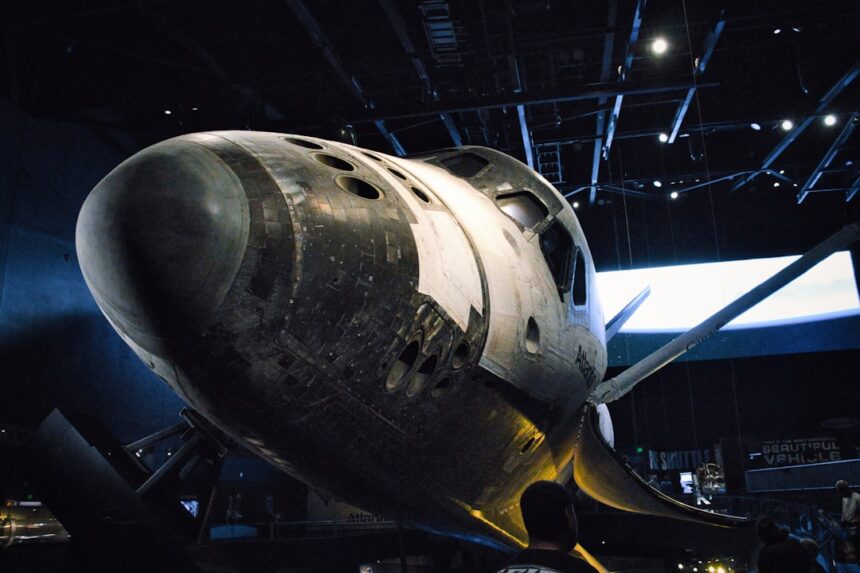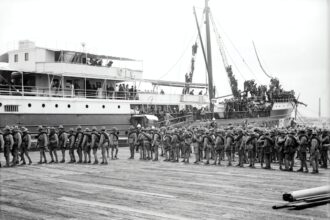The V-2 rocket, a groundbreaking achievement in the realm of aerospace engineering, emerged from the ambitious vision of German scientists during World War
Spearheaded by Wernher von Braun and his team, the development of the V-2 was marked by a series of innovative breakthroughs in propulsion and aerodynamics. Initially conceived as a weapon to strike at enemy targets, the V-2 represented a significant leap forward in rocket technology, utilizing liquid fuel and a sophisticated guidance system that allowed it to reach altitudes of over 180 kilometers. This marked the first time in history that a human-made object had traveled into the upper reaches of the atmosphere, paving the way for future advancements in space exploration.
The journey to create the V-2 was fraught with challenges, including technical setbacks and resource limitations. However, the relentless pursuit of knowledge and the desire to achieve supremacy in warfare drove the engineers to refine their designs continuously. By 1944, the V-2 was ready for deployment, and its first successful launch marked a turning point in military technology.
The rocket’s ability to deliver explosive payloads over long distances not only instilled fear in its adversaries but also showcased the potential of rocket technology beyond military applications. The V-2’s development laid the groundwork for future space missions, as it demonstrated the feasibility of reaching the edge of space and beyond.
Key Takeaways
- The V-2 rocket was the world’s first long-range guided ballistic missile, developed by Nazi Germany during World War II.
- Nazi Germany played a significant role in the development and deployment of V-2 rocket technology, using it as a weapon of war.
- Operation Paperclip facilitated the transfer of V-2 rocket technology and German engineers to the United States after the war, leading to advancements in American rocket technology.
- The V-2 rocket technology had a profound impact on the space race, influencing the development of intercontinental ballistic missiles and space exploration.
- V-2 rocket engineers made significant contributions to the development of NASA and played a crucial role in early space exploration missions.
The Role of Nazi Germany in V-2 Rocket Technology

Nazi Germany played a pivotal role in the advancement of V-2 rocket technology, driven by a combination of military ambition and scientific innovation. The regime recognized the potential of rocketry as a means to achieve strategic advantages over its enemies. Under the auspices of the German military, significant resources were allocated to research and development, leading to rapid advancements in propulsion systems and guidance technologies.
The V-2 project became a symbol of Nazi Germany’s technological prowess, showcasing their ability to harness science for warfare. The collaboration between scientists and military officials was instrumental in the V-2’s success. The regime’s focus on achieving technological superiority led to an environment where engineers like von Braun could experiment and innovate without the constraints typically imposed by civilian oversight.
This unique relationship fostered an atmosphere of creativity and urgency, resulting in breakthroughs that would have lasting implications for both military and civilian applications. However, this progress came at a significant ethical cost, as many of the scientists worked under conditions that exploited forced labor, raising profound moral questions about the legacy of their achievements.
Operation Paperclip and the Transfer of V-2 Rocket Technology to the United States
| Aspect | Details |
|---|---|
| Operation Paperclip | Secret program of the United States to recruit German scientists, engineers, and technicians, including Wernher von Braun, after World War II |
| V-2 Rocket Technology | Advanced rocket technology developed by Nazi Germany during the war, including the V-2 ballistic missile |
| Transfer to the United States | Scientists and engineers involved in the V-2 program were brought to the US to work on military and space projects, contributing to the development of American rocket technology |
| Impact | Significantly advanced the US space program and military capabilities, leading to the development of rockets such as the Redstone and Saturn series |
In the aftermath of World War II, Operation Paperclip emerged as a covert initiative aimed at harnessing German scientific expertise for American interests. Recognizing the strategic importance of rocket technology, U.S. officials sought to recruit key figures from the V-2 program, including Wernher von Braun and his team.
This operation facilitated the transfer of invaluable knowledge and experience that would shape the future of American aerospace endeavors. The U.S. government was keenly aware that securing these scientists would provide a significant advantage in the burgeoning Cold War context.
The implications of Operation Paperclip extended far beyond mere technological acquisition. It represented a complex interplay between ethics and pragmatism, as the United States grappled with the moral ramifications of employing individuals who had contributed to a regime responsible for horrific atrocities. Despite these concerns, the expertise brought by these scientists proved instrumental in advancing American rocketry.
Their work laid the foundation for NASA’s early programs and ultimately contributed to significant milestones in space exploration, including manned missions to the Moon.
The Impact of V-2 Rocket Technology on the Space Race
The V-2 rocket’s legacy profoundly influenced the trajectory of the Space Race between the United States and the Soviet Union during the Cold War. As both superpowers sought to demonstrate their technological superiority, they recognized that advancements in rocketry were crucial to achieving their goals. The V-2’s successful design and operational capabilities provided a blueprint for subsequent missile and space launch systems, serving as a catalyst for innovation on both sides of the Iron Curtain.
The technological advancements derived from V-2 research enabled both nations to develop intercontinental ballistic missiles (ICBMs) and space launch vehicles capable of carrying payloads into orbit. The race to achieve milestones such as satellite launches and human spaceflight was fueled by the foundational principles established during the V-2 program. As each nation sought to outpace the other, they invested heavily in research and development, leading to rapid advancements that would ultimately culminate in landmark achievements like Sputnik and Apollo 11.
The Contribution of V-2 Rocket Engineers to the Development of NASA

The engineers who had once worked on the V-2 rocket became instrumental figures in shaping NASA’s early endeavors. Wernher von Braun, in particular, emerged as a leading figure within NASA, where he played a crucial role in developing the Saturn V rocket that would eventually carry astronauts to the Moon. His expertise in propulsion systems and rocket design proved invaluable as NASA sought to achieve its ambitious goals during the 1960s.
The transition from military applications to peaceful exploration was not without its challenges; however, these former V-2 engineers brought with them a wealth of knowledge that significantly accelerated NASA’s progress. Their experience with complex systems allowed for rapid prototyping and testing, leading to innovations that would define America’s space program. The collaboration between these engineers and their American counterparts fostered an environment of creativity and ingenuity that propelled NASA into a new era of exploration.
V-2 Rocket Technology in Early Space Exploration Missions
The influence of V-2 rocket technology extended into early space exploration missions, where its principles were adapted for various applications. The design elements and engineering concepts developed during the V-2 program found their way into early satellite launches and suborbital flights. For instance, modifications of V-2 technology were utilized in launching scientific payloads into space, contributing to our understanding of atmospheric conditions and cosmic phenomena.
Moreover, the legacy of V-2 technology can be seen in early American space missions such as Project Mercury and Project Gemini. These programs relied on advancements made possible by previous work on rockets like the V-2, demonstrating how foundational research can have far-reaching implications. The ability to launch payloads into orbit laid the groundwork for subsequent missions that would explore deeper into space, ultimately leading to human landings on other celestial bodies.
The Legacy of V-2 Rocket Technology in Modern Space Exploration
The legacy of V-2 rocket technology continues to resonate within modern space exploration efforts. Its pioneering designs have influenced contemporary rocket systems used by various space agencies around the world. The principles established during its development—such as liquid propulsion systems and aerodynamic design—remain integral components of modern launch vehicles.
As nations strive for advancements in space travel, they often draw upon lessons learned from early rocketry. Furthermore, private companies have also embraced these foundational technologies as they seek to innovate within the aerospace sector. The commercial space industry has leveraged insights gained from historical programs like the V-2 project to develop reusable rockets and more efficient launch systems.
This ongoing evolution underscores how past achievements continue to inform present-day endeavors, ensuring that the spirit of exploration remains alive.
Challenges and Limitations of V-2 Rocket Technology in Space Exploration
Despite its groundbreaking achievements, V-2 rocket technology also faced significant challenges and limitations that have informed subsequent developments in aerospace engineering. One notable limitation was its reliance on liquid fuel, which posed risks related to handling and storage. Additionally, while it was capable of reaching high altitudes, its design was not optimized for sustained space travel or re-entry into Earth’s atmosphere.
These challenges highlighted the need for further innovation in rocket design and propulsion systems. As engineers sought to overcome these limitations, they began exploring alternative fuels and more advanced materials that could withstand extreme conditions encountered during space missions. The lessons learned from V-2 technology ultimately spurred advancements that would lead to more reliable and efficient rockets capable of supporting long-duration missions beyond Earth’s orbit.
The Influence of V-2 Rocket Technology on Rocket Design and Engineering
The influence of V-2 rocket technology on modern rocket design is undeniable. Its engineering principles laid a foundation upon which subsequent generations of rockets have been built. The emphasis on aerodynamics, stability during flight, and effective propulsion systems can be traced back to innovations introduced during the V-2 program.
These foundational concepts have been refined over time but remain integral to contemporary rocket engineering. Moreover, the collaborative spirit fostered during the development of the V-2 has persisted within aerospace engineering communities today. Engineers continue to share knowledge across borders and disciplines, building upon past successes while striving for new breakthroughs.
This culture of collaboration has led to remarkable advancements in rocket design that push the boundaries of what is possible in space exploration.
Ethical and Moral Considerations of Using V-2 Rocket Technology in Space Exploration
The ethical implications surrounding the use of V-2 rocket technology are complex and multifaceted. While its contributions to space exploration are significant, they are intertwined with a history marked by wartime atrocities and human suffering. The scientists who developed this technology operated within a regime responsible for heinous acts against humanity, raising questions about accountability and moral responsibility.
As society reflects on these ethical considerations, it becomes essential to acknowledge both the achievements made possible by this technology and its troubling origins. Engaging in discussions about how history informs present-day practices can help ensure that future advancements are pursued with an awareness of their potential consequences—both positive and negative.
Future Prospects and Innovations in V-2 Rocket Technology for Space Exploration
Looking ahead, future prospects for innovations inspired by V-2 rocket technology remain promising as humanity continues its quest for exploration beyond Earth. Researchers are actively investigating new propulsion methods that build upon foundational principles established during earlier rocketry efforts while seeking ways to enhance efficiency and sustainability. As commercial space travel gains momentum, there is potential for further advancements that could revolutionize how humans explore outer space.
By leveraging lessons learned from past technologies like the V-2 while embracing cutting-edge research initiatives today, engineers may unlock new possibilities that expand our understanding of the universe—ultimately fulfilling humanity’s enduring desire to explore beyond our planet’s confines. In conclusion, while rooted in a complex historical context marked by both innovation and ethical dilemmas, V-2 rocket technology has left an indelible mark on aerospace engineering and space exploration efforts worldwide. Its legacy continues to shape contemporary practices while inspiring future generations toward new frontiers among the stars.
The V-2 rocket technology, developed during World War II, marked a significant advancement in missile technology and laid the groundwork for future space exploration. After the war, the transfer of this technology played a crucial role in the development of both the American and Soviet space programs. An interesting article that delves into the intricacies of this technology transfer and its impact on post-war advancements can be found on the “In the War Room” website. For a detailed exploration of this topic, you can read more by visiting In the War Room.
WATCH THIS! 🪖How Stolen Nazis Built Cold War Power
FAQs
What is V-2 rocket technology transfer?
V-2 rocket technology transfer refers to the transfer of knowledge, technology, and expertise related to the development and production of V-2 rockets from Nazi Germany to other countries, particularly the United States and the Soviet Union, after World War II.
Why was V-2 rocket technology transferred?
After the end of World War II, both the United States and the Soviet Union sought to acquire the advanced rocket technology developed by Nazi Germany to gain a strategic advantage in the emerging Cold War. The V-2 rocket technology was seen as a valuable asset for the development of ballistic missiles and space exploration.
How was V-2 rocket technology transferred to the United States?
As part of Operation Paperclip, the United States recruited German scientists, engineers, and technicians, including Wernher von Braun, who had worked on the V-2 rocket program. These individuals were brought to the United States to work on the American rocket and missile development programs, bringing with them valuable knowledge and expertise.
How was V-2 rocket technology transferred to the Soviet Union?
The Soviet Union also captured German scientists and engineers, as well as V-2 rocket components and documentation, at the end of World War II. This information and expertise were used to kickstart the Soviet missile and space programs, leading to the development of their own ballistic missiles and space exploration efforts.
What impact did the transfer of V-2 rocket technology have?
The transfer of V-2 rocket technology had a significant impact on the development of ballistic missiles and space exploration in both the United States and the Soviet Union. It accelerated their respective rocket programs and played a crucial role in the early years of the space race.




